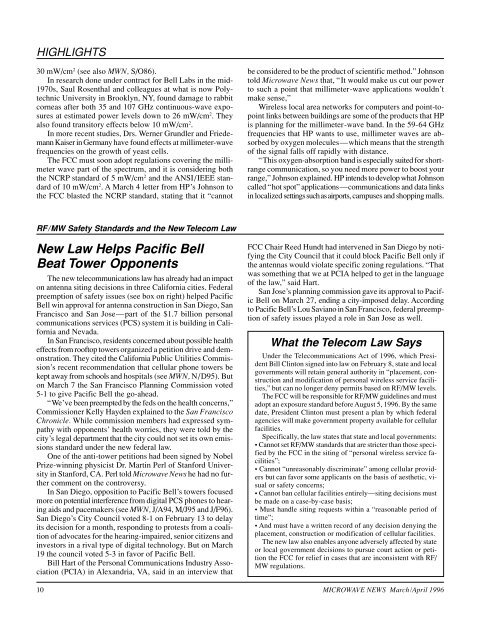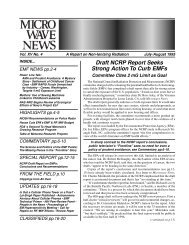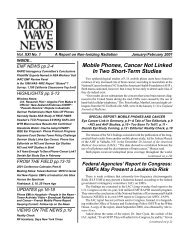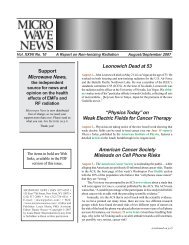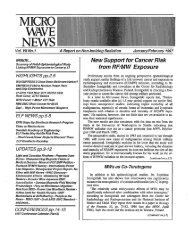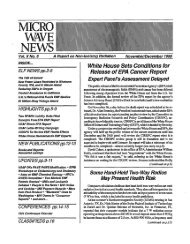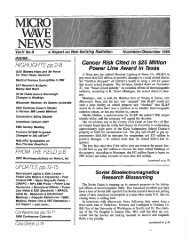Create successful ePaper yourself
Turn your PDF publications into a flip-book with our unique Google optimized e-Paper software.
HIGHLIGHTS<br />
30 mW/cm 2 (see also <strong>MWN</strong>, S/O86).<br />
In research done under contract for Bell Labs in the mid-<br />
1970s, Saul Rosenthal and colleagues at what is now Polytechnic<br />
University in Brooklyn, NY, found damage to rabbit<br />
corneas after both 35 and 107 GHz continuous-wave exposures<br />
at estimated power levels down to 26 mW/cm 2 . They<br />
also found transitory effects below 10 mW/cm 2 .<br />
In more recent studies, Drs. Werner Grundler and Friedemann<br />
Kaiser in Germany have found effects at millimeter-wave<br />
frequencies on the growth of yeast cells.<br />
The FCC must soon adopt regulations covering the millimeter<br />
wave part of the spectrum, and it is considering both<br />
the NCRP standard of 5 mW/cm 2 and the ANSI/IEEE standard<br />
of 10 mW/cm 2 . A March 4 letter from HP’s Johnson to<br />
the FCC blasted the NCRP standard, stating that it “cannot<br />
RF/MW Safety Standards and the New Telecom Law<br />
New Law Helps Pacific Bell<br />
Beat Tower Opponents<br />
The new telecommunications law has already had an impact<br />
on antenna siting decisions in three California cities. Federal<br />
preemption of safety issues (see box on right) helped Pacific<br />
Bell win approval for antenna construction in San Diego, San<br />
Francisco and San Jose—part of the $1.7 billion personal<br />
communications services (PCS) system it is building in California<br />
and Nevada.<br />
In San Francisco, residents concerned about possible health<br />
effects from rooftop towers organized a petition drive and demonstration.<br />
They cited the California Public Utilities Commission’s<br />
recent recommendation that cellular phone towers be<br />
kept away from schools and hospitals (see <strong>MWN</strong>, N/D95). But<br />
on March 7 the San Francisco Planning Commission voted<br />
5-1 to give Pacific Bell the go-ahead.<br />
“We’ve been preempted by the feds on the health concerns,”<br />
Commissioner Kelly Hayden explained to the San Francisco<br />
Chronicle. While commission members had expressed sympathy<br />
with opponents’ health worries, they were told by the<br />
city’s legal department that the city could not set its own emissions<br />
standard under the new federal law.<br />
One of the anti-tower petitions had been signed by Nobel<br />
Prize-winning physicist Dr. Martin Perl of Stanford University<br />
in Stanford, CA. Perl told <strong>Microwave</strong> <strong>News</strong> he had no further<br />
comment on the controversy.<br />
In San Diego, opposition to Pacific Bell’s towers focused<br />
more on potential interference from digital PCS phones to hearing<br />
aids and pacemakers (see <strong>MWN</strong>, J/A94, M/J95 and J/F96).<br />
San Diego’s City Council voted 8-1 on February 13 to delay<br />
its decision for a month, responding to protests from a coalition<br />
of advocates for the hearing-impaired, senior citizens and<br />
investors in a rival type of digital technology. But on March<br />
19 the council voted 5-3 in favor of Pacific Bell.<br />
Bill Hart of the Personal Communications Industry Association<br />
(PCIA) in Alexandria, VA, said in an interview that<br />
10<br />
be considered to be the product of scientific method.” Johnson<br />
told <strong>Microwave</strong> <strong>News</strong> that, “It would make us cut our power<br />
to such a point that millimeter-wave applications wouldn’t<br />
make sense,”<br />
Wireless local area networks for computers and point-topoint<br />
links between buildings are some of the products that HP<br />
is planning for the millimeter-wave band. In the 59-64 GHz<br />
frequencies that HP wants to use, millimeter waves are absorbed<br />
by oxygen molecules—which means that the strength<br />
of the signal falls off rapidly with distance.<br />
“This oxygen-absorption band is especially suited for shortrange<br />
communication, so you need more power to boost your<br />
range,” Johnson explained. HP intends to develop what Johnson<br />
called “hot spot” applications—communications and data links<br />
in localized settings such as airports, campuses and shopping malls.<br />
FCC Chair Reed Hundt had intervened in San Diego by notifying<br />
the City Council that it could block Pacific Bell only if<br />
the antennas would violate specific zoning regulations. “That<br />
was something that we at PCIA helped to get in the language<br />
of the law,” said Hart.<br />
San Jose’s planning commission gave its approval to Pacific<br />
Bell on March 27, ending a city-imposed delay. According<br />
to Pacific Bell’s Lou Saviano in San Francisco, federal preemption<br />
of safety issues played a role in San Jose as well.<br />
What the Telecom Law Says<br />
Under the Telecommunications Act of 1996, which President<br />
Bill Clinton signed into law on February 8, state and local<br />
governments will retain general authority in “placement, construction<br />
and modification of personal wireless service facilities,”<br />
but can no longer deny permits based on RF/MW levels.<br />
The FCC will be responsible for RF/MW guidelines and must<br />
adopt an exposure standard before August 5, 1996. By the same<br />
date, President Clinton must present a plan by which federal<br />
agencies will make government property available for cellular<br />
facilities.<br />
Specifically, the law states that state and local governments:<br />
• Cannot set RF/MW standards that are stricter than those specified<br />
by the FCC in the siting of “personal wireless service facilities”;<br />
• Cannot “unreasonably discriminate” among cellular providers<br />
but can favor some applicants on the basis of aesthetic, visual<br />
or safety concerns;<br />
• Cannot ban cellular facilities entirely—siting decisions must<br />
be made on a case-by-case basis;<br />
• Must handle siting requests within a “reasonable period of<br />
time”;<br />
• And must have a written record of any decision denying the<br />
placement, construction or modification of cellular facilities.<br />
The new law also enables anyone adversely affected by state<br />
or local government decisions to pursue court action or petition<br />
the FCC for relief in cases that are inconsistent with RF/<br />
MW regulations.<br />
MICROWAVE NEWS March/April 1996


